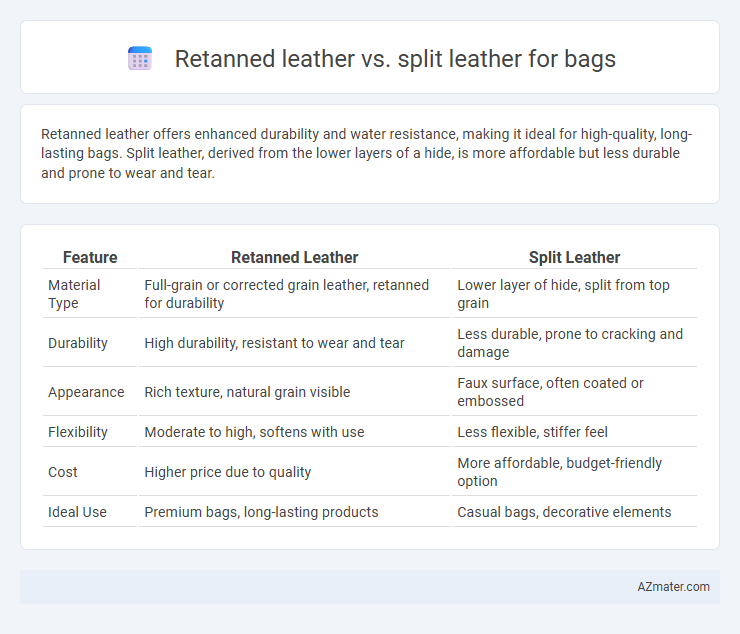Retanned leather offers enhanced durability and water resistance, making it ideal for high-quality, long-lasting bags. Split leather, derived from the lower layers of a hide, is more affordable but less durable and prone to wear and tear.
Table of Comparison
| Feature | Retanned Leather | Split Leather |
|---|---|---|
| Material Type | Full-grain or corrected grain leather, retanned for durability | Lower layer of hide, split from top grain |
| Durability | High durability, resistant to wear and tear | Less durable, prone to cracking and damage |
| Appearance | Rich texture, natural grain visible | Faux surface, often coated or embossed |
| Flexibility | Moderate to high, softens with use | Less flexible, stiffer feel |
| Cost | Higher price due to quality | More affordable, budget-friendly option |
| Ideal Use | Premium bags, long-lasting products | Casual bags, decorative elements |
Understanding Retanned Leather: Key Features
Retanned leather undergoes a secondary tanning process, enhancing its durability, flexibility, and water resistance, making it ideal for high-quality bags. This method improves the leather's grain integrity and ensures a softer, more supple texture compared to split leather, which is made from the fibrous lower layers of the hide and lacks the natural grain. The superior finish and increased strength of retanned leather contribute to a longer-lasting, more premium bag product.
Split Leather: Composition and Characteristics
Split leather is made by separating the fibrous part of the hide from the top-grain layer, resulting in a lower-quality but more affordable material for bags. Its composition includes the inner layers of the hide, which are softer and more porous, offering a suede-like texture but less durability and water resistance compared to full-grain retanned leather. Split leather is often coated or embossed to enhance appearance and improve resistance, making it a popular choice for budget-friendly fashion bags.
Durability Comparison: Retanned vs Split Leather Bags
Retanned leather offers superior durability compared to split leather, as it undergoes an additional tanning process that enhances its strength and resistance to wear. Split leather, derived from the lower layers of the hide, tends to be less robust and more prone to scratches and tearing, making it less ideal for heavy-use bags. High-quality retanned leather bags maintain their structural integrity and appearance longer, providing better value for consumers seeking longevity.
Appearance and Texture Differences
Retanned leather exhibits a smooth, uniform surface with a rich, consistent color, ideal for high-quality bags that demand a polished appearance. Split leather features a rougher texture with visible grain inconsistencies, resulting from separating the hide layers, often yielding a more casual or rugged look. The denser, firmer feel of retanned leather contrasts with the lighter, more flexible nature of split leather, influencing the bag's overall durability and tactile experience.
Cost Analysis: Retanned Leather vs Split Leather Bags
Retanned leather bags generally come with higher production costs due to the additional tanning processes that enhance durability and finish quality, making them more expensive than split leather bags. Split leather, derived from the lower layers of the hide, offers a more budget-friendly option but often compromises on strength and longevity, affecting its overall value. Consumers weighing retanned versus split leather for bags should consider the balance between initial cost and long-term durability for a cost-effective investment.
Water Resistance and Maintenance Needs
Retanned leather offers superior water resistance compared to split leather, making it a more durable choice for bags exposed to moisture. Split leather lacks the dense fiber structure of retanned leather, resulting in higher susceptibility to water damage. Maintenance for retanned leather involves regular conditioning to preserve its water-resistant properties, while split leather requires more frequent care and waterproofing treatments to prevent cracking and degradation.
Environmental Impact of Each Leather Type
Retanned leather undergoes additional chemical treatments that enhance durability but often involve environmentally harmful substances such as chromium salts and heavy metals, leading to challenges in waste disposal and water pollution. Split leather, typically derived from the fibrous part of the hide leftover after full-grain leather is separated, is generally less durable and often coated with synthetic finishes that can contain volatile organic compounds (VOCs), contributing to air pollution and limited biodegradability. Both types require considerable water and energy during manufacturing, but retanned leather's complex processing tends to have a higher environmental footprint compared to split leather's simpler treatment stages.
Common Uses in the Bag Industry
Retanned leather is commonly utilized in high-quality bags due to its enhanced durability, richer texture, and improved resistance to water and wear, making it ideal for luxury and designer handbags. Split leather, derived from the lower layers of the hide, is often used in budget-friendly bags or as backing material because of its lower cost and less refined surface. Manufacturers in the bag industry select retanned leather for products requiring longevity and premium appeal, while split leather suits mass-produced, affordable styles where cost efficiency is prioritized.
Pros and Cons: Retanned Leather Bags
Retanned leather bags offer enhanced durability and a richer color spectrum due to secondary tanning processes, making them highly resistant to wear and ideal for long-term daily use. Their natural grain retention provides a premium texture and aesthetic but can come with a higher price tag compared to split leather options. In contrast, split leather bags tend to be more affordable and flexible but lack the strength and refined finish of retanned leather, which may result in quicker wear and reduced structural integrity.
Pros and Cons: Split Leather Bags
Split leather bags offer affordability and a softer texture, making them a popular choice for budget-conscious consumers. However, they tend to be less durable and more prone to wear and tear compared to full-grain or retanned leather, which may affect longevity. These bags often require additional treatment or coating to improve water resistance and maintain appearance over time.

Infographic: Retanned leather vs Split leather for Bag
 azmater.com
azmater.com